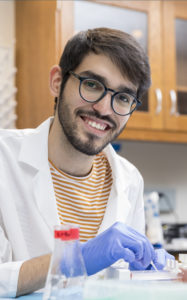
“I also incorporated skills from outside of the natural sciences into my research. For example, I mapped species distributions using skills I acquired in a geography course.” —Pietro Tardelli Canedo
By Pietro Tardelli Canedo ’19
São Paulo, Brazil
Biology, data science minor
 I vividly remember hearing about Professor Sarah Boyer’s research on the first day of my first-year course “Creatures and Curiosities” back in 2015. I was captivated by the research questions and findings, and immediately knew I wanted to work in the Boyer Lab. This goal became a reality last summer thanks to grants from the Beltman Program and the National Science Foundation.
I vividly remember hearing about Professor Sarah Boyer’s research on the first day of my first-year course “Creatures and Curiosities” back in 2015. I was captivated by the research questions and findings, and immediately knew I wanted to work in the Boyer Lab. This goal became a reality last summer thanks to grants from the Beltman Program and the National Science Foundation.
Our work aimed to understand the evolution, diversity, and distribution of mite harvestmen, an intriguing group of daddy longlegs. We were especially focused on three genera that live exclusively in New Zealand: Aoraki, Rakaia, and Neopurcellia. Their distribution is largely shaped by past geological events, such as sea level rises, glaciation, and uplift of mountain ranges. By understanding the interactions between those geological processes and evolutionary processes, we can answer more complex questions regarding the species’ biodiversity and biogeography.
In the lab, we used genetic material to reconstruct the phylogenetic relationships of these organisms in hopes of better understanding their diversity and evolutionary history. We also relied on scanning electron microscopy (SEM) to image the details of these tiny specimens, many of which are crucial for distinguishing species from one another. Most recently, we discovered the presence of pores in the backs of some individuals which have not been previously described in scientific literature. In line with Macalester’s interdisciplinary focus, I also incorporated skills from courses outside of the natural sciences into my research experience. For example, I mapped species distributions and ran biogeographic models using skills I acquired in Introduction to Geographic Information Systems (GIS), a geography course.
The opportunity to work closely with my professors has been crucial in shaping my academic interests and passions. Professor Boyer helped me and the other students become well-versed in lab techniques and let us gravitate toward the areas of the research that most interested us. Working with my lab mates, Eliza Pessereau ’19 and Rina Morisawa ’20, has also been a highlight of my research experience. We would often bounce ideas off one another and share our findings, creating a close-knit community and a fun work environment. And in January 2019, the three of us will head to the South Island of New Zealand with Professor Boyer (and Harvard PhD candidate and Boyer Lab alumna Caitlin Baker ’12) to conduct fieldwork and collect more specimens for our database. My research experience will culminate in my senior honors thesis, in which I will be exploring the morphology, phylogeny, and biogeography of the genus Neopurcellia in further detail.
February 15 2019
Back to top




